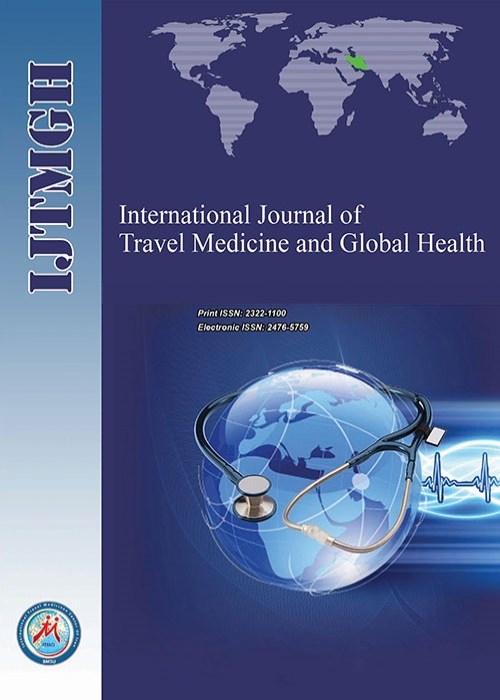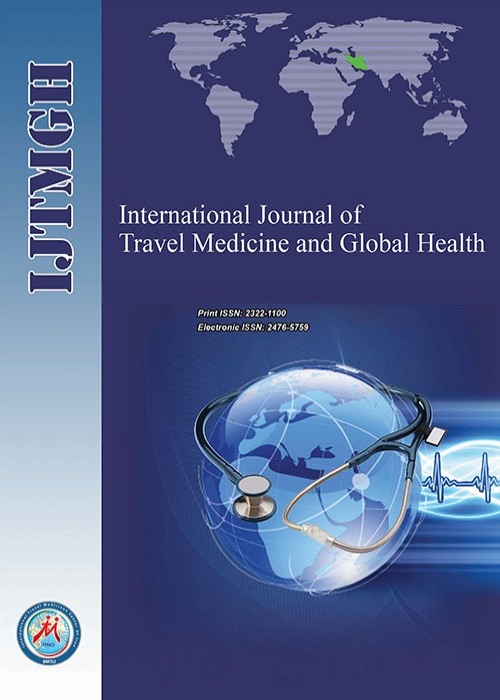فهرست مطالب

International Journal of Travel Medicine and Global Health
Volume:11 Issue: 3, Summer 2023
- تاریخ انتشار: 1402/06/10
- تعداد عناوین: 9
-
-
Pages 311-319IntroductionSatisfaction from the supervisor is considered one of the important factors in the choice and successful advancement of students' theses. In addition to the supervisor's academic skills, the ability to communicate with the student and guide him/her in the direction of the thesis project is also important. This article aimed to evaluate the criteria for supervisor selection by doctoral students of the Pasteur Institute of Iran.MethodsThis study was an instrument-development variant of sequential exploratory mixed method design, and also was a cross-sectional descriptive study that was accomplished in two qualitative and quantitative parts. The collection instrument of the qualitative part was a purpose-based interview until the time of information saturation, and the instrument of the quantitative part was the multicast questionnaire in terms of the Likert standard, which was completed by the community members. After analysis, the findings of the two steps were combined to answer the research questions.ResultsAmong 181 students of the Pasteur Institute of Iran that participated in the research, 104 people had 22-52 years old. Friendly attitude, honesty, ability to provide financial support, friendly environment, observation of the research ethics principles and avoidance of academic theft, and finally the support of the supervisor in the defense session have got the most priority among this study participants, especially among female students. Accordingly, the supervisor’s academic rank, his/her experience, and ability in patent and invention registration, along with the opinion of the past student and others have the least importance.ConclusionAccording to this research, the possibility of creating a good job position after graduation, the possibility of continuing their studies at higher levels, or creating suitable conditions for immigrating to advanced countries in addition to gaining the best situation at the final the thesis are the reasons for the high sensitivity of students in choosing a supervisor for their thesis.Keywords: Supervisor, Advisor, Assessment, Ph.D. candidate satisfaction
-
Pages 320-323
Onychogryphosis is a disorder caused by nail trauma. Although it may have an evolutionary cause, hitting and wearing tight shoes are significant factors. Case presentation The patient was a 64-year-old man with a 20-year history of diabetes and coronary heart disease who presented to the wound clinic for a diabetic foot ulcer on his right foot. Onychogryphosis, also known as ram's horn nail, was diagnosed due to the high thickness, rotation, and downward twisting of the nail, resulting in a ram-like horn appearance. After disinfecting the fingers with an alcohol-free disinfectant spray, large and hard parts of the affected nails were removed using Dual-action nail clippers, and sharp edges and deformations were smoothed and sharpened using a nail file machine. Substantial nail improvement was observed after the procedure. Based on the photos taken after the procedure, the patient's nails were in good condition, and the patient was satisfied with the outcome. Appropriate foot health education was provided to the patient, and he was referred to an orthotics and prosthetics specialist to obtain suitable shoes.
Keywords: Onychogryphosis, ram’s horn nail, Trauma, Diabetes -
Pages 324-334
In travel medicine, vaccinations play a crucial role in both protecting passengers and preventing the spread of diseases that can be prevented by vaccination in both the travelers' home countries and the places they go to. The first smallpox vaccine, created by Edward Jenner, was initially made available in 1796, marking the beginning of travel-related vaccination. Typhoid, Rabies, and cholera vaccines were created after this discovery, albeit it took over a century to make such a substantial advancement.Travelers now have access to vaccinations for hepatitis A, yellow fever, poliomyelitis, tetravalent meningococcal disease, and poliomyelitis as the 20th century came to a close. To make it easier for tourists to prove their immunizations, the International Certificate of Inoculation and Vaccination was developed in 1933. Nowadays, in addition to following the rules outlined in the 2005 International Health Regulations and the unique requirements of other countries, passengers receive vaccinations based on individual risk assessments. The COVID-19 pandemic's appearance was of particular significance because it ignited a never-before-seen rush to create vaccinations. The first COVID-19 vaccinations received emergency use authorisation to stop the spread of the virus within a year of the pandemic's announcement. The verification of COVID-19 vaccination status has been widespread, especially in foreign travel, since the spring of 2021, while confronting a number of practical and ethical problems. In this article, we provide a summary of the historical development of travel-related vaccinations with a focus on those for which vaccination documentation has been or is still required.
Keywords: travel vaccine, Yellow Fever, Smallpox, Hepatitis A, Japanese Encephalitis -
Pages 337-344Introduction
Mountaineers, especially professional ones, are exposed to unusual environments that are not tolerable for most ordinary people. Some available studies suggest that mountaineers have different personality traits from ordinary people; however, there is not enough evidence to support this claim. This study aimed to investigate differences in the personality traits of mountaineers that may influence their decision-making in risky situations.
MethodsIn this study, a short form of the Minnesota Multiphasic Personality Inventory (MMPI, 71 questions) was used to assess the personality traits of 85 mountaineers who were members of mountaineering clubs. The eight dimensions of hypochondriasis (Hs), depression (D), hysteria (Hy), psychopathic deviate (Pd), paranoia (Pa), psychasthenia (Pt), schizophrenia (Sc), and hypomania (Ma) were compared with the results of 62 individuals in the control group. Independent t-test, Chi-square, and three-way ANOVA test were performed in SPSS version 21 for data analysis.
ResultsThere were no significant differences between the two groups in terms of hypochondriasis, depression, hysteria, paranoia, and psychasthenia, whereas psychopathic deviate, schizophrenia, and hypomania were significantly higher in the mountaineer group compared to the control group. Despite these differences, the MMPI profile was normal for both the mountaineer and control groups.
ConclusionAlthough mountaineers had significantly different personality traits, they did not show any specific problems in the MMPI, which can potentially affect their decision-making in risky environments. The higher levels of hypomania in mountaineers can explain their participation in high-risk physical activities.
Keywords: Mountaineering, alpinists, psychology, personality, MMPI -
Pages 345-354Background
Cardiovascular disease (CVD) is the leading cause of death among international travellers. Online travel health information is largely focused on infectious disease despite the higher burden of CVD in this patient population. There have not been any studies assessing the availability of key travel health information online for patients with CVD.
MethodsWebsites of national societies of cardiology (NSC) affiliated with the European Society of Cardiology (ESC) were included in the study. A list of NSCs affiliated with ESC was obtained from the ESC website. All travel health information on the websites identified was analysed. Additional websites of medical societies not affiliated with ESC were assessed for comparison. Each NSC was individually contacted and asked to complete an anonymised questionnaire to identify any measures taken by each NSC towards travel health promotion among travellers with CVD.
ResultsTwo (4.5%) NSC websites contained relevant travel information. Topics addressed were venous thromboembolism (VTE) and pulmonary embolism (PE) prophylaxis, high altitude travel, implanted cardiac devices (ICD) and atrial fibrillation. The questionnaire arm of the study revealed that the majority of NSCs agree that travel health is an important aspect of CVD prevention and that there is a lack of online travel health information for this population.
ConclusionConsidering the significant risks travel can impose on patients with CVD, there is a disproportionate lack of information on this subject online.
Keywords: Travel Health, Cardiovascular disease, preventive medicine, European Society of Cardiology, air travel -
Pages 355-368
The global outbreak of COVID-19 as a pandemic posed one of the most critical conditions for the healthcare system. This study aimed to provide a comprehensive potential transfection of COVID-19 disease to humans from pets. This study is a systematic review of the latest data on COVID-19 in the animal community (wildlife, pets, and farm) from June 2017 to May 2022. Published studies were searched in various databases, including Google Scholar, PubMed, Scopus, ISI Web of Knowledge, and Embase. Searching, data gathering, and analysis were accomplished by two reviewers separately, and conflicts between them were resolved by a third expert reviewer. In the initial research, 83 articles were found for full-text evaluation. After the reviewers’ assessment, 32 articles were included. Finally, the organisms studied in the mentioned research were classified into laboratory and non-laboratory research. The first group of laboratory animals includes rats, hamsters, guinea pigs, rhesus monkeys, macaques, and pigs. In the second group, non-laboratory patients, less than 100 dogs and cats, 6 cases of large cats, 2 cases of snakes (reptiles), and 12 cases of mink and bats were included. In dogs and cats, the symptoms are more in upper respiratory tract infections, while in herbivores, these symptoms are more in the form of enteritis and diarrhea, and gastrointestinal symptoms. Infection of dogs and cats is mainly accompanied by coughing and sneezing, while there are no reports of herbivores. Animal studies suggested that other animals can be hosted with COVID-19.
Keywords: COVID-19, animals, PET -
Pages 369-381BackgroundAnti-immigrant sentiment is a macro-level determinant of how immigrants are treated in a country. However, very few studies test whether anti-immigrant sentiments at the macro level are associated with individual-level outcomes such as the well-being of immigrants.AimIn the current study and built on a multi-level model of happiness, as well as marginalization-related diminished returns (MDRs) theory that shows immigrants show worse-than-expected outcomes, we conducted this study to test the association between country-level anti-immigrant sentiments and individual-level happiness across European countries.MethodsFor this cross-sectional study, we borrowed data from European Social Survey 2020 (ESS 2020). Participants were recruited from Bulgaria, Czechia, Estonia, Finland, France, Croatia, Hungary, Lithuania, Slovenia, and Slovakia. Participants included 997 individuals who identified as an immigrant. Age, sex, education, employment (worked in the past week), and self-rated health were control variables. Country-level anti-immigrant sentiment was the independent variable. Happiness was the outcome. Linear regression was used for data analysis.ResultsOverall, a higher level of anti-immigrant sentiment was associated with a lower level of immigrants' happiness. The results remained similar without and with control variables (age, gender, education, employment, and self-rated health) in the model.ConclusionHigher anti-immigrant sentiments, at the macro-level, are associated with a lower level of happiness of immigrants at the individual level. Research should test if country-level anti-immigrant sentiments contribute to reduced opportunities and worse treatment of immigrants.Keywords: Immigration, Public opinions, Health
-
Pages 382-390
Medical tourism, as a flourishing and profitable industry, has attracted the attention of many countries. The purpose of the present research was to propose a model to improve the competitiveness of Iran's medical tourism industry. In terms of philosophical foundations, the present study was interpretive. It is applied and developmental in nature. It was also inductive and followed a qualitative approach. The data collection method was a semi-structured interview following a review of the related literature. The research population comprised 110 hospitals formally permitted to treat foreigners. The sample consisted of 10 interviewees selected in a convenience sampling method. The data collection continued until data saturation. The collected data were analyzed in MAXQDA2020. Having coded the transcribed interviews, the authors extracted 175 keywords (Memo). After standardization, the codes were divided into 15 main categories and 77 sub-categories, which included: government support, standardization of medical services, development of medical tourism, quality of medical services, cost of medical services, hospital facilities and equipment, branding, marketing, advertising, culture, and so forth. As the findings showed, Iran is not yet prepared for the globalization and competitiveness of the healthcare services it provides. In the first place, attention to and satisfaction of domestic needs seem to be essential along with a scientific and technological development, standardization, advertisement and marketing of health services.
Keywords: model, Competitiveness, Medical tourism, Industry, Iran


